🤍 Unmatched Quality, Authentic Craftsmanship
🤍 Unmatched Quality, Authentic Craftsmanship
🤍 Unmatched Quality, Authentic Craftsmanship
Welcome to our article on creating a Japandi Feng Shui kitchen, where simplicity meets natural beauty to bring harmony and tranquility into your home.
In this guide, we will explore the fusion of the Japandi aesthetic and Feng Shui principles to help you design a kitchen space that promotes balance and well-being.
Get ready to discover Feng Shui kitchen design ideas and learn how to incorporate them into your own home.
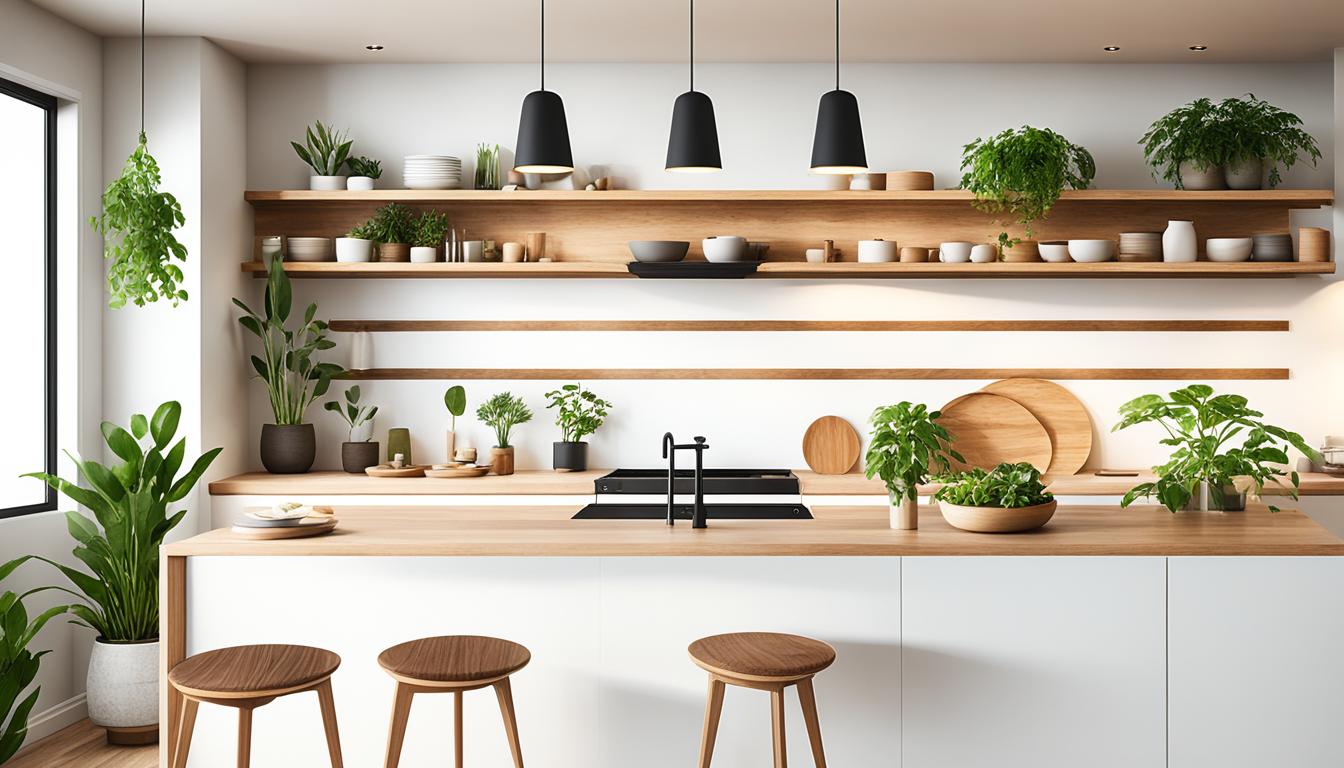
In this section, we will take a closer look at the Japandi aesthetic in kitchen design.
Japandi is a fusion of Japanese and Scandinavian styles, characterized by its emphasis on simplicity, natural beauty, and functional design.
Japandi design blends the minimalist elegance of Japanese aesthetics with the cozy warmth of Scandinavian interiors.
It embraces clean lines, uncluttered spaces, and a neutral color palette to create a serene and harmonious atmosphere.
By integrating natural materials like wood, bamboo, and stone, Japandi kitchens exude a sense of organic beauty.
A Japandi Feng Shui Kitchen incorporates key elements that contribute to a balanced and harmonious space. These elements include:
By incorporating these key elements, a Japandi Feng Shui Kitchen creates a space that embraces simplicity, natural beauty, and positive energy flow, allowing for a harmonious and serene culinary experience.
In order to create a harmonious kitchen, it is important to incorporate Feng Shui principles into the design and arrangement of the space.
By considering the flow of energy, proper placement of appliances, and the use of feng shui colors for kitchen to balance energy, you can create a kitchen that promotes positive energy and overall well-being.
One key principle of Feng Shui is ensuring a smooth flow of energy, or chi, throughout the kitchen.
This can be achieved by arranging furniture and appliances in a way that allows for easy movement and avoids blocking pathways.
By creating a space that allows energy to flow freely, you can promote a sense of calmness and balance in the kitchen.
The placement of kitchen appliances is also important in Feng Shui.
For example, the stove represents wealth and abundance, so it should be placed in a commanding position where the cook can see the entrance to the kitchen.
This symbolizes prosperity flowing into the home. Additionally, keeping the kitchen clean and organized is essential for maintaining a positive energy flow.
The use of colors in the kitchen can also play a significant role in creating harmony.
Feng Shui recommends choosing colors that promote balance and tranquility. For instance, earthy tones like beige, brown, and soft greens can create a grounding and calming effect.
On the other hand, bright or bold colors should be used sparingly to avoid overwhelming the space.
To visually enhance this section and provide a relevant illustration, here is an image that represents Feng Shui principles and kitchen harmony:
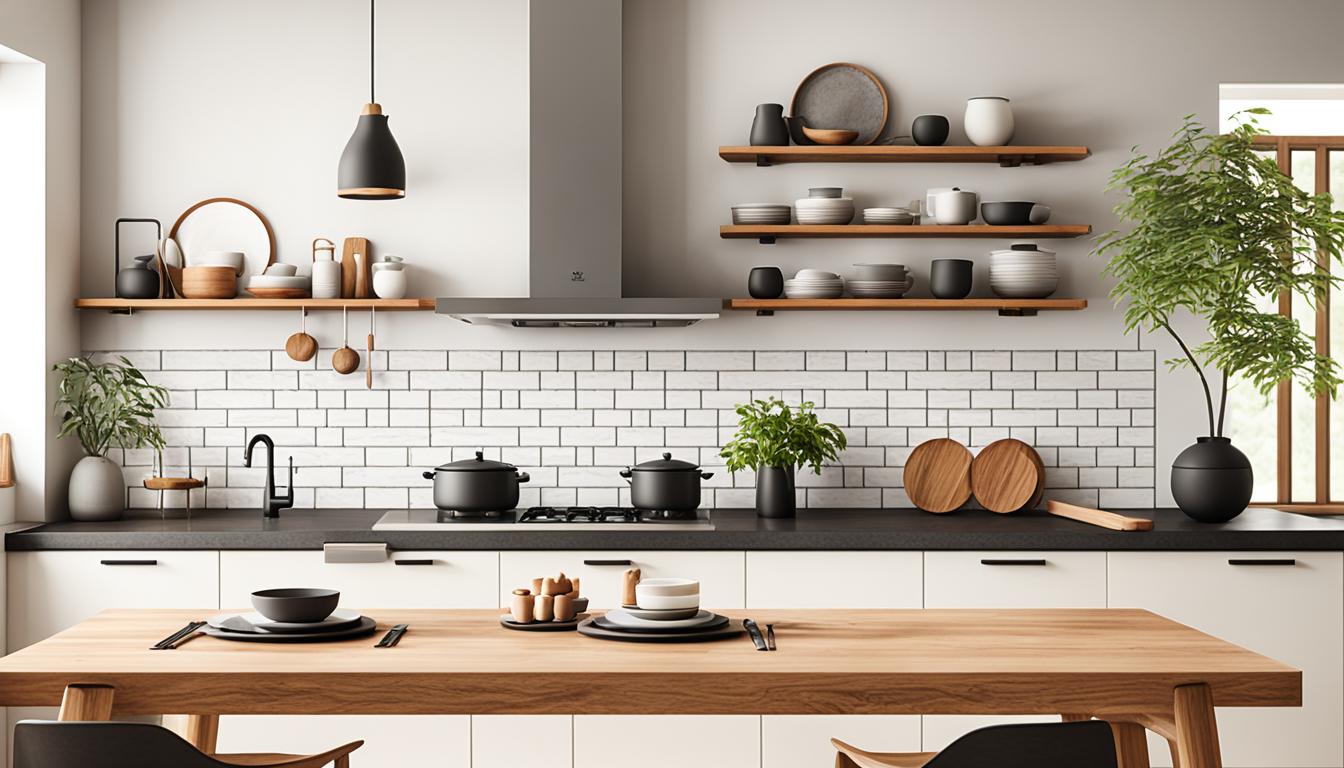
| Feng Shui Principles for Kitchen Harmony | Implementations |
|---|---|
| Ensure smooth flow of energy (chi) | Arrange furniture and appliances for easy movement |
| Proper placement of kitchen appliances | Position the stove in a commanding position |
| Use of colors to balance energy | Choose earthy tones for grounding and calmness |
By implementing these Feng Shui principles into your kitchen design, you can create a space that not only looks beautiful but also promotes harmony and positive energy.
From the flow of chi to the proper placement of appliances and the use of colors, every aspect of your kitchen can contribute to a balanced and tranquil environment.
In Japandi kitchens, color plays a crucial role in creating a harmonious and serene atmosphere.
Neutral palettes, such as shades of white, beige, and gray, are often used to evoke a sense of calmness and tranquility.
These muted tones provide a blank canvas for the natural elements and minimalist design that are characteristic of Japandi style.
Neutral colors have the power to affect moods and create a soothing environment.
They promote relaxation and can help reduce stress and anxiety.
By using neutral palettes in your Japandi kitchen, you can establish a peaceful space where you can unwind and find balance.
In addition to neutral palettes, incorporating Feng Shui colors into your Japandi kitchen can further enhance the balance and harmony of the space.
Feng Shui is an ancient Chinese practice that focuses on the flow of energy, or chi, within a space.
By using specific colors associated with the five elements of Feng Shui - wood, fire, earth, metal, and water—you can create a sense of balance and harmony in your kitchen.
For example, adding touches of green, the color of wood, can bring a nurturing and rejuvenating energy to the space.
Meanwhile, incorporating red, the color of fire, can add passion and vitality.
By carefully selecting and balancing these colors, you can create a kitchen that not only looks visually appealing but also promotes positive energy and well-being.
| Element | Color | Meaning |
|---|---|---|
| Wood | Green | Growth, Nurturing |
| Fire | Red | Passion, Vitality |
| Earth | Yellow, Brown | Stability, Grounding |
| Metal | White, Gray | Purity, Clarity |
| Water | Blue, Black | Flow, Relaxation |
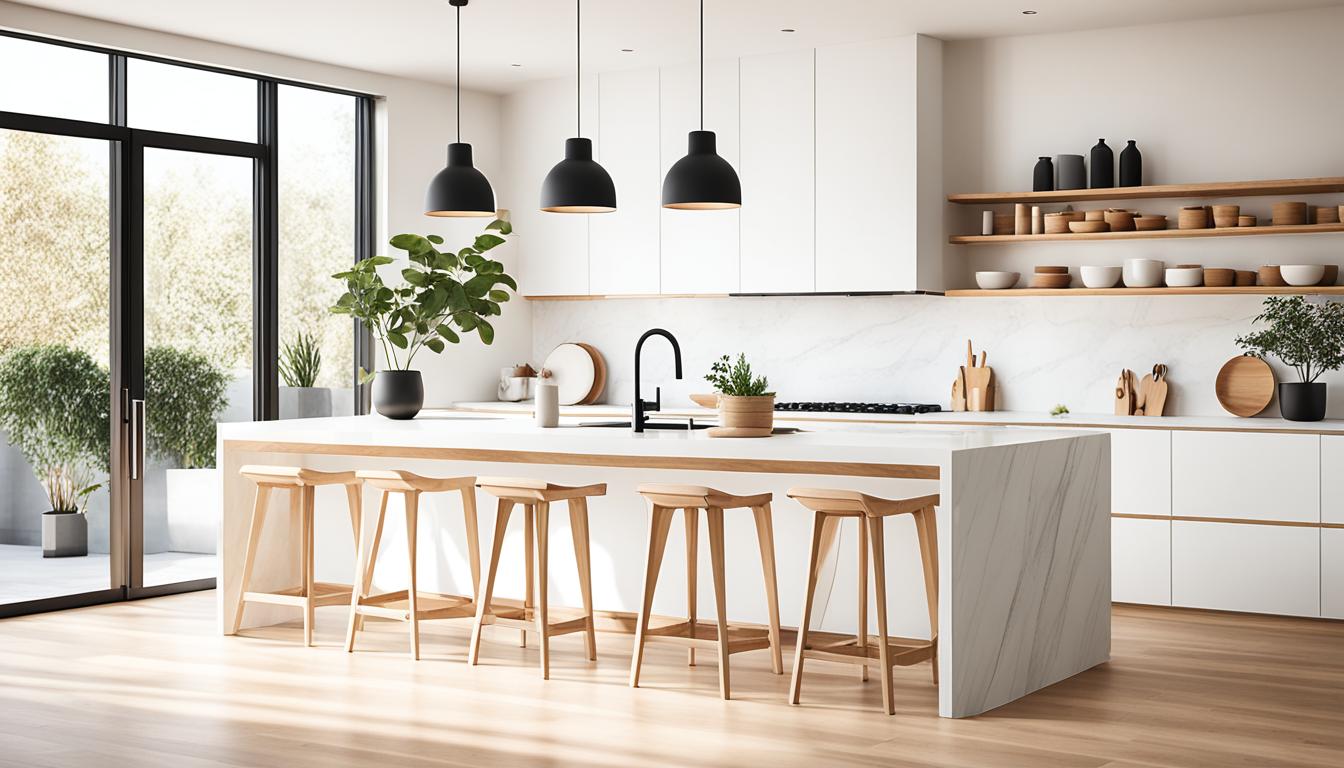
In our quest to create a harmonious living space, the kitchen plays a vital role.
As the heart of the home, it is essential to design a kitchen that promotes balance and tranquility.
This is where the concept of a Japandi Feng Shui Kitchen comes into play, combining the simplicity and natural beauty of Japandi design with the principles of Feng Shui.
By blending these two philosophies, we can create a space that not only serves our functional needs but also fosters a sense of harmony and well-being.
At the core of a Japandi Feng Shui Kitchen is the idea of crafting harmony in both form and function.
The clean lines and minimalist aesthetic of Japandi design create a serene and clutter-free environment, allowing energy to flow freely.
The use of natural materials, such as wood and stone, adds warmth and authenticity to the space, connecting us to nature and promoting a sense of groundedness.
| Benefits of a Japandi Feng Shui Kitchen | Feng Shui Principles in Action |
|---|---|
| Creates a tranquil and balanced atmosphere | Proper placement of kitchen appliances to enhance positive energy flow |
| Promotes a sense of mindfulness and well-being | Use of colors to balance the elements and create a harmonious space |
| Enhances functionality with thoughtful design and organization | Integration of lighting to create a harmonious ambiance |
| Adds a touch of natural beauty and authenticity to your home | Incorporation of wood and organic materials for grounding energy |
A Japandi Feng Shui Kitchen is more than just a place to cook and eat.
It is a sanctuary within your home, a space where you can find solace and create nourishment for both the body and the soul.
By carefully considering the design elements, implementing Feng Shui principles, and incorporating the essence of Japandi, you can craft a kitchen that not only looks beautiful but also promotes a sense of harmony and well-being in your home.
In Japandi kitchens, the flexible use of space is a key aspect of creating a harmonious and functional environment.
With careful planning and design, you can maximize functionality without sacrificing aesthetics, while also ensuring privacy and openness.
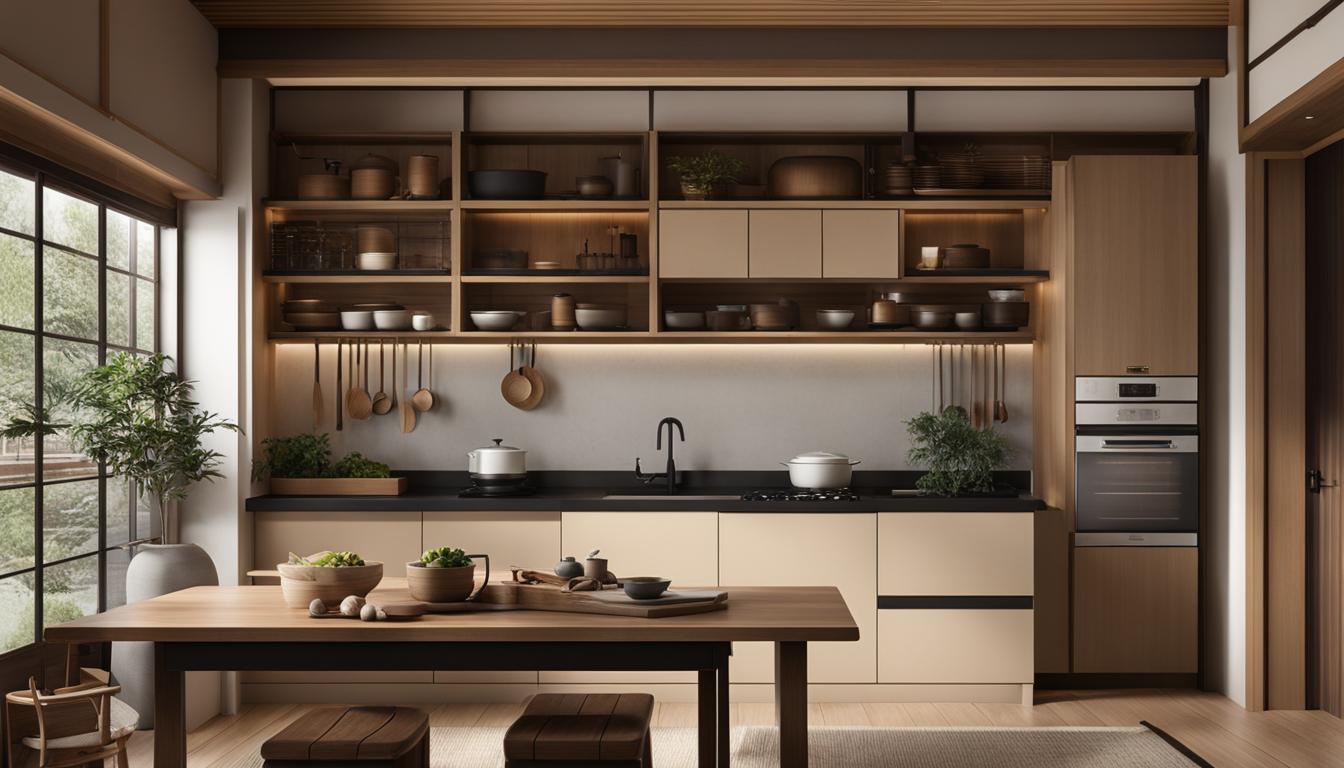
A Japandi kitchen allows for a seamless blend of functionality and aesthetics.
By incorporating smart storage solutions, such as built-in cabinets and hidden drawers, you can keep your kitchen organized while maintaining a minimalist look.
Consider utilizing vertical space by installing tall cabinets or shelves to maximize storage capacity without compromising the clean lines and simplicity of the Japandi design.
Additionally, multi-functional furniture and appliances, such as kitchen islands with built-in storage or dining tables that double as workstations, can effectively optimize space utilization.
Creating a sense of privacy and openness in a Japandi kitchen is essential for fostering a calming and inviting atmosphere.
While an open floor plan is often preferred for its seamless flow, it's important to delineate distinct areas within the kitchen to ensure privacy when needed.
Utilize sliding or frosted glass doors to separate the kitchen from adjacent spaces, striking a balance between openness and privacy.
Additionally, incorporating natural materials, such as wooden screens or room dividers, can add a touch of warmth while still allowing for visual connectivity.
By achieving a flexible use of space in your Japandi kitchen, you can create a functional, visually appealing, and harmonious environment that complements your lifestyle and enhances the overall ambience of your home.
Incorporating natural elements into your kitchen can transform it into a serene and peaceful space.
By creating a Zen kitchen atmosphere with nature's touch, you can bring a sense of tranquility and connection to the outdoors into your cooking space.
One way to achieve this is by using natural materials such as wood and stone. These materials not only add visual warmth and texture to your kitchen but also create a natural and inviting ambiance.
Consider incorporating wooden cabinets, countertops, or flooring to bring a touch of nature indoors.
Another way to infuse nature into your kitchen is by incorporating plants.
Adding houseplants or herbs to your kitchen not only enhances the aesthetics but also improves air quality and brings a sense of freshness.
Choose plants that thrive in low-light conditions and are suitable for kitchens, such as pothos, snake plant, or herbs like basil and rosemary.
In addition to natural materials and plants, consider incorporating natural colors and textures into your kitchen design.
Earthy tones, such as greens, browns, and neutrals, can create a calming and grounded atmosphere.
You can also introduce natural textures through textiles, such as linen or jute placemats, to add depth and interest to your kitchen decor.
By creating a Zen kitchen atmosphere with nature's touch, you can transform your kitchen into a peaceful sanctuary where you can unwind, cook, and connect with the beauty of the natural world.
In order to create a harmonious kitchen space, lighting plays a crucial role.
It not only provides functionality but also enhances the overall ambiance and comfort of the space.
In this section, we will explore the concept of layering light to achieve both function and comfort in your kitchen.
Additionally, we will discuss how to choose the right lighting fixtures that complement the Japandi style, adding the perfect finishing touch to your harmonious kitchen.
When it comes to lighting a Japandi-style kitchen, layering light is key.
This involves using a combination of different lighting sources to create depth and variety.
By incorporating multiple layers of light, you can achieve a balanced and well-lit space that caters to both your functional and comfort needs.
Start by considering the three main types of lighting: ambient, task, and accent.
Ambient lighting provides overall illumination to the space, task lighting focuses on specific work areas, and accent lighting adds a touch of drama and highlights key design elements.
By strategically layering these different types of lighting, you can create a balanced and functional kitchen space that is both practical and visually appealing.
When selecting lighting fixtures for your Japandi-style kitchen, it is important to choose those that align with the minimalist and natural aesthetic of the design.
Opt for fixtures with clean lines, simple silhouettes, and natural materials such as wood, bamboo, or metal.
Consider using pendant lights with a paper or bamboo shade, or opt for minimalist track lighting that can be adjusted to focus light on specific areas.
Additionally, incorporating natural light sources, such as skylights or large windows, can contribute to the overall harmony and connection with nature in your kitchen space.
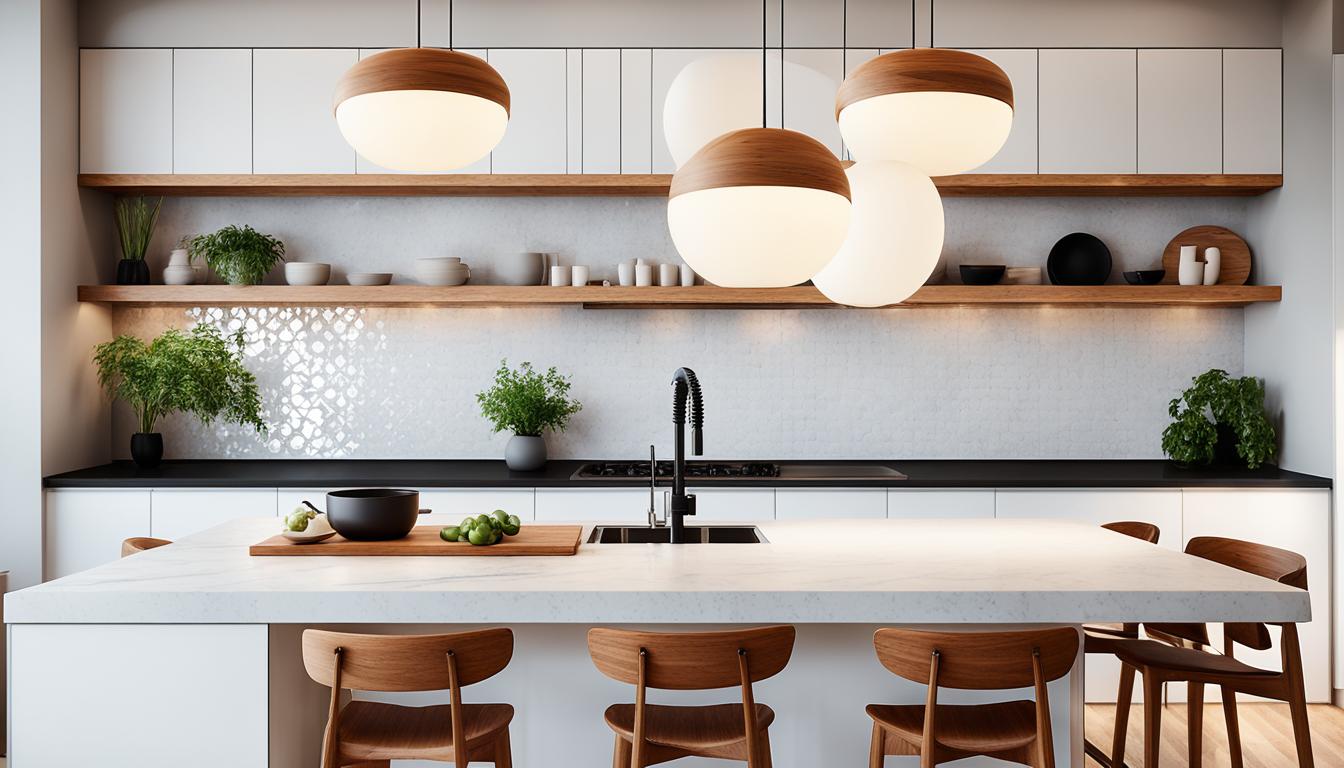
Remember, the lighting fixtures you choose should not only provide adequate illumination but also blend seamlessly with the Japandi style to create a cohesive and harmonious kitchen design.
In a Japandi kitchen, functionality and aesthetics go hand in hand.
To maximize the efficiency and beauty of your kitchen space, consider incorporating multi-functional furniture.
By choosing pieces that serve multiple purposes, you can create a harmonious and clutter-free environment.
Multi-functional furniture not only adds beauty to your Japandi kitchen but also enhances practicality.
Look for pieces that seamlessly blend into the overall design while offering additional functionality.
For example, a kitchen island with built-in storage or a dining table that can be extended to accommodate more guests.
Japandi design embraces the concept of creative storage solutions to optimize space and maintain a clutter-free environment.
Consider incorporating built-in cabinets, shelves, and drawers that are not only visually appealing but also provide ample storage.
Utilize vertical space by installing hooks or racks for hanging pots, pans, and utensils.
By integrating multi-functional furniture and creative storage solutions, you can enhance the beauty, practicality, and functionality of your Japandi kitchen.
This will not only create a visually stunning space but also make your day-to-day kitchen activities more enjoyable and efficient.
In a Japandi kitchen, the art of blending textures takes center stage, creating a harmonious and cozy atmosphere.
By carefully selecting fabrics and finishes, you can transform your kitchen into a warm and inviting space that embodies the essence of Japandi design.
The selection of fabrics and finishes plays a crucial role in creating a cozy Japandi kitchen.
Opt for natural materials such as linen, cotton, and wool to add warmth and comfort to the space.
Incorporate soft and tactile textiles for curtains, table linens, and cushions to create a sense of coziness.
Choose finishes that have a natural, matte appearance, such as wood or stone, to enhance the organic feel of the kitchen.
Texture is key in achieving a cozy Japandi kitchen. Embrace various textures throughout the space to add depth and interest to your design.
Consider integrating textured tiles for the backsplash or a rustic wooden countertop to introduce visual and tactile elements.
Use textured paint or wallpaper to create an accent wall that adds character and warmth to the kitchen.
By incorporating different textures, you can create a visually appealing and inviting environment that blends seamlessly with the Japandi aesthetic.
| Texture | Effect |
|---|---|
| Textured tiles | Adds visual interest and depth |
| Rustic wooden countertop | Brings a natural and organic feel |
| Textured paint or wallpaper | Creates an accent wall and adds character |
Incorporating a blend of textures not only adds visual appeal but also creates a welcoming and cozy ambiance that is synonymous with Japandi design.
By carefully selecting fabrics, finishes, and utilizing texture to add depth and interest, you can create a truly cozy Japandi kitchen that invites both comfort and tranquility into your home.
Now that you have read the above article, maybe you still have a couple of questions on this topic, so we will answer these questions below.
A Japandi Feng Shui Kitchen is a kitchen design that combines the minimalist and natural aesthetics of Japandi style with the principles of Feng Shui.
It aims to create a harmonious and serene space that promotes positive energy and well-being.
The key elements that define a Japandi Feng Shui Kitchen include minimalist decor, natural materials like wood and stone, functional design, and a focus on balance and harmony.
It emphasizes simplicity, authenticity, and creating a space that promotes positive energy flow.
Feng Shui principles can be implemented in a kitchen by ensuring proper chi flow, strategic placement of kitchen appliances, and the use of colors to balance the energy.
By following these principles, you can create a kitchen that promotes a sense of harmony and well-being.
In a Japandi kitchen, neutral palettes are often used to create a calm and soothing atmosphere.
However, different colors can also be incorporated to evoke specific moods.
When it comes to Feng Shui colors, it is recommended to choose colors that correspond to the elements, such as blues for water and greens for wood, to balance the energy in the kitchen.
Lighting plays a crucial role in creating a harmonious kitchen space.
By layering light for both function and comfort, you can enhance the overall ambiance and promote a sense of balance.
Choosing the right lighting fixtures that complement the Japandi style is also important in creating a harmonious atmosphere.
In conclusion, creating a Japandi Feng Shui kitchen can bring harmony and tranquility to your home.
By incorporating Japandi design elements, such as simplicity, natural beauty, and functional design, you can create a kitchen space that promotes balance and serenity.
The fusion of simplicity and natural beauty in the Japandi aesthetic creates a serene atmosphere in your kitchen.
The minimalist decor, use of natural materials, and functional design elements define a Japandi Feng Shui kitchen, creating a space that is both visually appealing and highly functional.
Implementing Feng Shui principles further enhances the harmony in your kitchen.
Proper chi flow, the placement of kitchen appliances, and the use of colors to balance energy are important considerations when creating a harmonious kitchen space.
By crafting a minimalist kitchen with Japandi influences, you can create a clutter-free space that exudes tranquility.
From choosing minimalist kitchen appliances and accessories to incorporating natural materials, every detail contributes to the authentic Japandi aesthetic.


